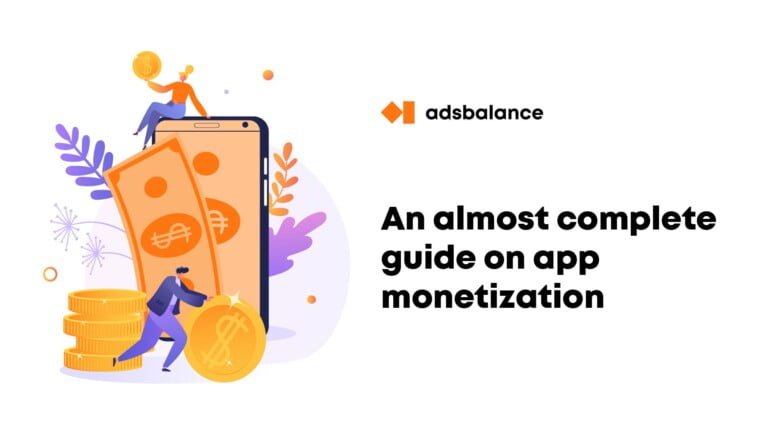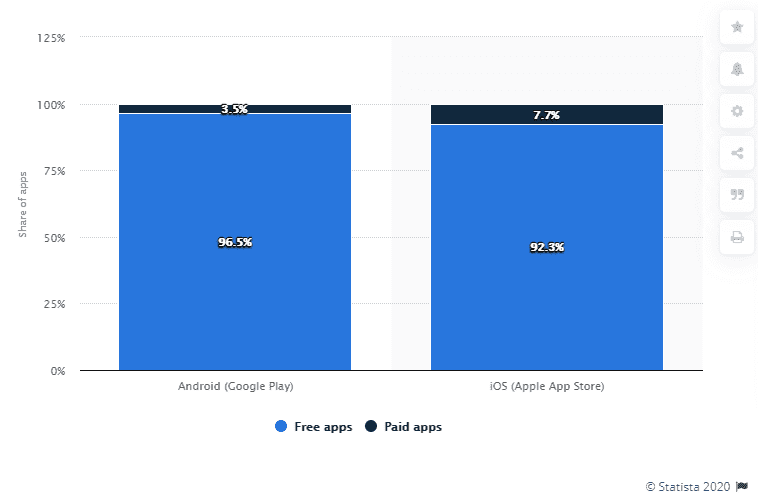
Almost any app released comes with a monetization strategy in mind, be it a vague notion of what you could earn from a large built-in SDKs pack and a couple of advertising contracts already signed. Anyway, if you have developed an app and have no slightest idea of how to monetize it, don’t worry: we’re here to help, because better late than never is a relevant statement here.
What is app monetization in general?
It is a number of ways to gain revenue from your app, which is important since mobile consumption (compared to desktop and regular media) share still grows every year, according to comScore. Some of those ways can be used simultaneously (=at the same time) so that you’re sure you don’t miss an opportunity to earn from your product: for most product types it’s the only way to stay self-sustained unless you are a charity/governmental project and are funded heavily — despite the fact that at the same time most products are free to download in the beginning. Each product category usually has its most suitable way of monetization.
Another important thing — last, but not least — is that adjusting the monetization logics helps you analyse the user behavious and user flow in your app to make sure your users have everything they need and have it the right way, so you might think of it as another challenge.
According to App Annie, 2018 total app revenue reached $101 billion dollars ($71 billion as of Sensor Tower), which is impressive and might help you head forward to grabbing your piece of that pie. Experts expect it to almost double in 2020 (which we are soon to find out, but the current world situation has already give the industry the additional boost)
How do you monetize an app?

As we have already mentioned, the share of free apps in Google Play and App store is 96.5 and 92.3 accordingly (see the 2020 report picture taken from Statista.com below),
As we have already mentioned, the free apps prevail, which means that the other 3.5 and 6.7% need a payment to be downloaded. That’s the simplest way to put it: both free and paid models have their own sub-types. For example, a subscription app is technically free to download but is impossible to use unless you buy a (surprise!) buy a subscription or start a free trial if there is such option. The low number of paid apps is slowly but steadily getting lower every year but this doesn’t imply this can’t be your model of choice.
So, what are the pecularities of the paid downloads model?
As we already mentioned, the number of paid apps is not that significant, but it doesn’t prevent it from being a good option!
What are the pros?
There are much fewer paid apps (well, it depends on your genre, but still), so the pre- and post-release market research requires a smalleYor number of direct and likely competitors to observe
The model itself is a no-brainer: you don’t need to look deeply into user psychology and choose the best moments and circumstances of in-app purchases, as well as the value of each.
The previous point also means that your revenue analytics is pretty straightforward: you know the LTV of each user at once..
..and get your revenue at an instant as well!
You don’t need to adjust your interface for the additional payments steps of ads, so your design and user journey are free to be as pure and clean as they can.
You are supposed to have more infromation on your user behavior and usage patterns: paid users tend to pay more attention to the products they purchased, they are less likely to give up on them, so the average time spent is higher and the retention rate is lower. Isn’t that music to your ears?
Last, but not least: your app promotion is ultra-transparent. If you are new to the market, it might be hard for you to figure out the best terms for working with user acquisition partners, but here you can easily settle upon CPI model (which is also comportable for your partners in many ways) and save the calculations and negotiations time. You have your revenue guaranteed and the parter is able to know thether working for you is profitable in no time. Also, your analytics team won’t spend sleepless nights thinking about the traffic quality of consider buying an anti-fraud analytics add-ons: as long as the users make purchases, you can go easy on where they come from. (of course, it’s only for good it you give it some attention: some of the ad fraud methods are outstandingly exquisite and it’s wise to know your enemy before you face them (next time, in another app, for example). We have an article on the point if you’re ready for the devil in the details.
What are the cons?
How do you know if this model suits my app type?
Any app can be that (well, almost: we can’t imagine a social network with a one-time initial feel, and it would be too good to have a video/music streaming service with a single for forever). Though we have noticed that desktop (also paid) utilities analogs (like Photoshop, for instance) optimized for the device and performa very well, maybe because they are signigicantly cheaper than their enterprtise desktop siblings and their value is predictable and easy to estimate.
In-App Purchases: what are they all about?
In-app purchases, in spite of being a simple notion, can take many forms: an extra workout in a fitness app, a one-time cheat for a mobile game, a new user level or reward, or a premium feature in a productivity app. The important thing to remember is that your app should be functional without the additional purchase; with the add-on serving to enhance the user experience.
Pros
Having a free app will attract considerably more users at the start.
It’s fairly low risk as you’re not denying users access to critical features or content.
You can make a hefty profit as in-app purchases are digital upgrades and don’t require storage or maintenance of physical stock.
As users acquire add-ons, the experience improves and this, in turn, boosts loyalty.
Can use this in conjunction with other monetization strategies.
Cons
Even if users love your app, some will never purchase anything. When you monetise this way, revenue can fluctuate greatly.
As with paid apps, Google and Apple take a large cut from any profits you make.
You may encounter more requests for refunds if someone accidentally makes a purchase (like a child playing around with his or her parent’s tablet).
Advertising (in-app ads)
Ad revenue is an extremely popular app monetization strategy. With this method, you’re selling space within your app for advertisements. Some of you might be familiar with this model if you display ads on your website.
According to a recent survey of the world’s top app publishers, mobile advertising is the most effective method of app monetization.
App advertising can come in all different shapes and sizes. Not only are there different types of ad formats (video ads, banner ads, native ads, pop-ups, interstitial ads, etc.), but there are also different revenue models within this category:
CPC (cost-per-click)
CPI (cost-per-install)
CPA (cost-per-action)
CPM (cost-per-mile)
CPV (cost-per-view)
How you’re paid and how much you get paid depends on a wide range of factors. For example, simply displaying a banner ad with a CPV revenue model usually won’t pay as much as CPC or CPI model.
Check out our guide on the top mobile ad networks to help facilitate ads within your app. This resource contains an in-depth description of the various revenue models as well. Ad networks help ensure the ads displayed within your app are relevant to your target audience.
While in-app advertisements are popular and profitable, they’re definitely not for everyone. Sometimes ads can hinder the user experience, and ultimately make your app less desirable. So you need to take this into consideration before blindly adding ads to your app.
In-App Subscriptions
In-App Subscriptions (also referred to as “freemium content”) is similar to in-app purchases in that the spending of money opens users up to new parts of the app experience.
However, the main difference is that in-app purchases are typically items, events, or content that are viewed as a bonus or reward. They’re not contingent on moving on or being able to experience the whole app.
In-app subscriptions, on the other hand, offers users the very basic, slimmed-down version of the app. Options for paid premium upgrades are then made available so they can “unlock” the rest of the experience.
With mobile apps, this usually comes in the form of gated content you can access after subscribing. You can also sell subscriptions that allow users to remove all traces of ads in their mobile app interface (this is a feature MobiLoud News supports!).
Benefits:
Perfect for news sites and blogs that have a steady readership.
Easy to amass users since it’s like a try-before-you-buy opportunity.
To maximize profits, you can sell in-app content subscriptions outside the app store. Premium members then have to log in. (FYI: MobiLoud includes this login feature.)
Subscriptions provide you with recurring revenue; not unpredictable one-off buys.
Drawbacks:
Selling in-app subscriptions through the app store allows Apple and Google to take a large cut.
Content offered in the premium app needs to be supremely valuable.
It will need to be constantly updated with fresh, relevant content.
Need to strike the right balance between what’s included in the free and premium versions. You want to inspire them to upgrade, but not turn them off altogether.
Did you find any model appealing enough to try right away? Drop us a line, and Adsbalance team will help you choose the right medium to skyrocket your campaign reach!




